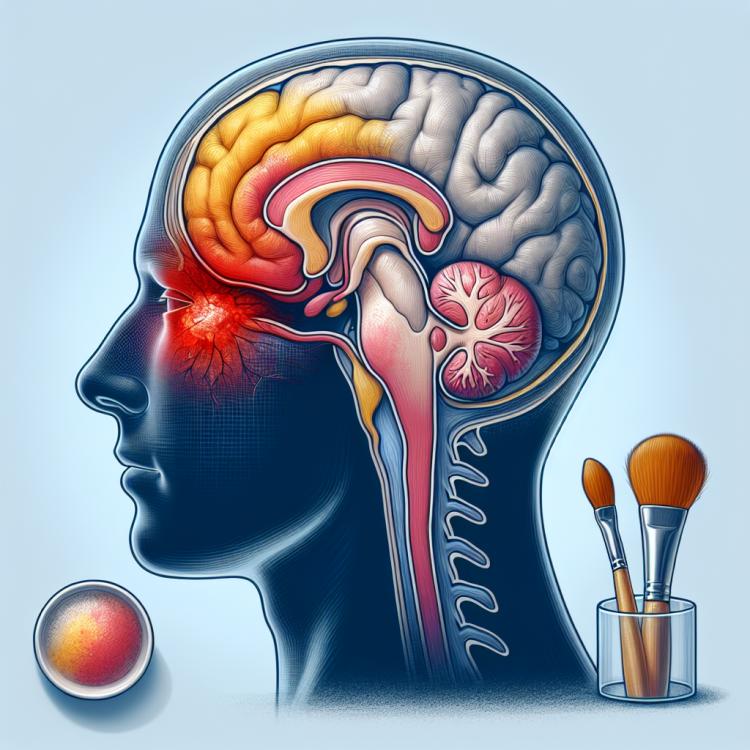
Sphenoiditis: diagnosis, treatment, and complications
- Understanding Sphenoiditis: Symptoms, Causes, and Treatment
- Etiology of sphenoiditis
- Clinical picture of sphenoiditis
- Expert opinion on the treatment of sphenoiditis
- Diagnosis methods for sphenoiditis
- Methods of treating sphenoiditis
- Preventive measures for sphenoiditis
- Amazing aspects of sphenoiditis
- FAQ
Understanding Sphenoiditis: Symptoms, Causes, and Treatment
Sphenoiditis is an inflammatory disease of the sphenoid sinus, characterized by a set of specific symptoms, including headaches in the forehead and occipital areas, a feeling of pressure in the eye sockets, as well as vision disturbances. The cause of sphenoiditis is most often bacterial infections, as well as respiratory viruses. Treatment of this disease includes the use of antibiotics to combat the infection, as well as symptomatic therapy to alleviate the patient’s discomfort. In case of complications, such as the spread of infection to surrounding tissues or the development of an abscess, surgical intervention may be required.
Etiology of sphenoiditis
Sphenoiditis, an inflammatory disease of the sphenoid sinus, can arise from various causes. The main cause of sphenoiditis is a bacterial infection, which most often occurs due to the spread of infection from neighboring regions, such as the upper respiratory tract or teeth. In addition, other potential causes may include allergic reactions, anatomical features, systemic diseases, or even trauma.
Factors that contribute to the development of sphenoiditis include impaired sinus drainage, weakened immunity, and the presence of mucous formations that can serve as foci of infection. Understanding the main causes of sphenoiditis not only aids in proper diagnosis but also determines approaches to successful treatment of this condition.
- Bacterial infection: The development of sphenoiditis is often associated with the penetration of bacteria into the sphenoid tissue through other affected areas of the body.
- Allergic reactions: Some allergens can trigger inflammation of the mucous membrane of the sphenoid sinus, causing symptoms of sphenoiditis.
- Systemic diseases: Some systemic diseases can increase the risk of developing sphenoiditis due to disruption of the body’s immune system.
- Anatomical features: Uneven or abnormal structure of the sphenoid tissue and associated structures may contribute to the development of inflammation.
- Injuries: Injuries to the facial or skull area can lead to damage to the sphenoid sinus, providing a pathway for infection and the development of sphenoiditis.
Clinical picture of sphenoiditis
The clinical picture of sphenoiditis can manifest with various symptoms, which often include headaches, especially in the forehead area and at the back of the head, as well as in the eye socket area. Patients may complain of general malaise, deterioration of smell and hearing, as well as nosebleeds and purulent nasal discharge. Some patients may exhibit neurological symptoms such as double vision, vision disturbances, clouding of consciousness, or dizziness.
With symptoms suggesting sphenoiditis, it is important to consult a doctor for an accurate diagnosis and appropriate treatment. Since the symptoms of sphenoiditis can be varied and individual, professional medical examination is necessary for the correct identification of the disease and the development of an effective treatment strategy.
- Headaches: one of the main symptoms of sphenoiditis is headaches, often localized in the forehead and the back of the head.
- Smell and hearing: patients may experience a worsening sense of smell and hearing problems associated with sphenoiditis.
- Nasal bleeding: a symptom of sphenoiditis may be expressed by the presence of nasal bleeding and discharge with purulent admixtures.
- Neurological symptoms: some patients may experience double vision, vision disturbances, blurred consciousness, or dizziness due to sphenoiditis.
- General malaise: patients with sphenoiditis may suffer from general malaise, weakness, apathy, and decreased work capacity related to the disease.
Expert opinion on the treatment of sphenoiditis
Expert doctors note that the treatment of sphenoiditis depends on the type and severity of the disease. In most cases, conservative therapy is used, which includes the use of antibiotics to fight bacterial infection, anti-inflammatory drugs to reduce inflammation and alleviate symptoms, as well as local remedies to ease breathing and reduce swelling of the mucous membrane.
However, in some cases, especially in the presence of complications or recurrences, surgical intervention may be required. Experts recommend an individual approach to each patient with sphenoiditis, taking into account their overall health, medical history, and the characteristics of the disease for optimal selection of treatment methods and achieving the best results.

Diagnosis methods for sphenoiditis
The diagnosis of sphenoiditis includes various methods, starting with clinical examination and patient history. It is important to pay attention to the characteristics of symptoms, possible sources of infection, as well as the history of previous illnesses. To confirm the diagnosis, instrumental methods of investigation are usually carried out, such as computed tomography (CT) or magnetic resonance imaging (MRI) of the sinuses, which help determine the degree of inflammation and pathological changes in the sphenoid area.
Laboratory tests, such as blood analysis and samples of nasopharyngeal discharge, can be used to identify the inflammatory process and determine the pathogen of the infection. It is important to conduct a comprehensive diagnostic examination for the accurate identification of sphenoiditis and to determine the optimal treatment method for this condition.
- General clinical examination: Includes gathering of medical history, evaluation of symptoms, and physical examination of the patient to identify signs of sphenoiditis.
- Instrumental methods: Computed tomography (CT) and magnetic resonance imaging (MRI) of the sinuses allow visualization of the structure of the sphenoid area and identification of pathological changes.
- Laboratory studies: Blood tests, including complete blood count and biochemical indicators, as well as analysis of nasopharyngeal discharge, can assist in additional diagnosis of sphenoiditis.
- X-ray: X-ray of the sinuses can be used for additional assessment of pathological changes and the degree of inflammation in the sphenoid area.
- Endoscopy: Endoscopic examination allows for visual assessment of the mucosa of the sinuses, aiding in the diagnosis and treatment planning of sphenoiditis.
Methods of treating sphenoiditis
- Antibiotics: Used to eliminate bacterial infection, which is often the main cause of sphenoiditis.
- Local vasoconstrictors: Help to reduce swelling and decrease the mucous membrane in the sinuses, easing breathing and drainage.
- Anti-inflammatory drugs: Used to reduce inflammation in the sphenoidal area, decrease pain sensations, and normalize the mucous membrane.
- Surgical intervention: May be needed to drain the sinuses or remove formations that could be the source of the problem.
- Physical therapy: Used to improve sinus drainage, reduce swelling, and expedite the recovery process.
Preventive measures for sphenoiditis
Another important aspect of prevention may be avoiding prolonged stays in dry and dusty environments, regular ventilation of living and working spaces, as well as moderate fluid intake to moisturize the mucous membranes. Adhering to these simple measures will help reduce the risk of developing sphenoiditis and other upper respiratory diseases.
- Strengthening the immune system: Maintaining a strong immune system will help the body fight infections more effectively, including sphenoiditis.
- Following personal hygiene rules: Regular hand washing, cleaning nasal passages, and overall adherence to hygiene standards help prevent the transmission of infections.
- Avoiding contact with sick people: Limiting contact with infected individuals reduces the risk of contracting various infections, including those that can lead to sphenoiditis.
- Ventilating premises: Regularly airing living and workspaces provides fresh air and reduces the concentration of bacteria and viruses indoors.
- Healthy lifestyle: Engaging in sports, eating healthy, quitting smoking, and avoiding overwork help maintain overall health and strengthen the immune system, which contributes to the prevention of sphenoiditis.
Amazing aspects of sphenoiditis
Thanks to modern diagnostic methods and advanced treatment principles, sphenoiditis has become more accessible for successful therapy. Therefore, it is important to seek medical assistance at the first signs of suspicion of this condition to prevent possible complications and achieve complete recovery.